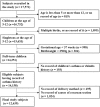Cesarean section without medical indication and risks of childhood allergic disorder, attenuated by breastfeeding
- PMID: 28852079
- PMCID: PMC5575109
- DOI: 10.1038/s41598-017-10206-3
Cesarean section without medical indication and risks of childhood allergic disorder, attenuated by breastfeeding
Abstract
Caesarean section (CS) may increase the risk of asthma and allergic diseases in children, but previous studies could not preclude the potential confounding effect of underlying medical indications for CS. We aim to assess the association between CS itself (without indications) and risks of asthma and allergic rhinitis in children. The 2014 Shanghai Children's Health, Education and Lifestyle Evaluation was a large population-based survey with cluster random probability sampling in 26 primary schools in Shanghai, China, in 2014. The mode of delivery and child history of asthma and allergic rhinitis were reported by parents. We included 12639 children in our analysis. CS without medical indication was associated with an increased risk of childhood asthma. CS without medical indication and CS for fetal complications were associated with increased risks of childhood allergic rhinitis, respectively. In children fed by exclusive breastfeeding or mixed feeding in the first four months after birth, these risks were not significant. In contrast, in children fed by exclusive formula milk, CS was highly significantly associated with childhood asthma and allergic rhinitis. In conclusion, CS without medical indication was associated with increased risks of both childhood asthma and allergic rhinitis. Breastfeeding in early infancy may attenuate these risks.
Conflict of interest statement
The authors declare that they have no competing interests.
Figures


References
Publication types
MeSH terms
LinkOut - more resources
Full Text Sources
Other Literature Sources
Medical

